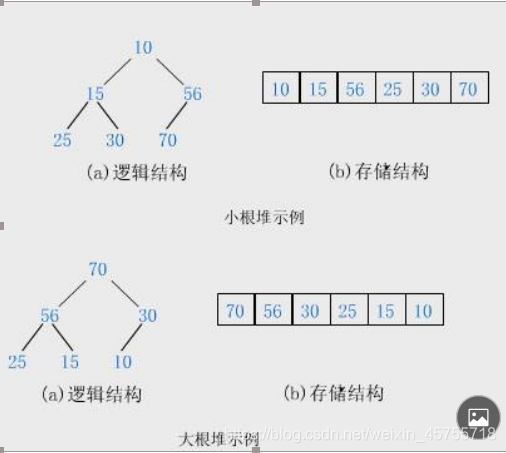堆得概念:
- 堆逻辑上是一棵完全二叉树
- 堆物理上是保存在数组中
- 满足任意结点的值都大于其子树中结点的值,叫做大堆,或者大根堆,或者最大堆
- 反之,则是小堆,或者小根堆,或者最小堆
- 堆的基本作用是,快速找集合中的最值
 优先级队列概念:
优先级队列概念:
在很多应用中,我们通常需要按照优先级情况对待处理对象进行处理,比如首先处理优先级最高的对象,然后处理次高的对象。最简单的一个例子就是,在手机上玩游戏的时候,如果有来电,那么系统应该优先处理打进来的电话。
在这种情况下,我们的数据结构应该提供两个最基本的操作,一个是返回最高优先级对象,一个是添加新的对象。
这种数据结构就是优先级队列(Priority Queue)。
下面是关于队列的一些操作。
public class MyPriorityQueue {
private int[] array = new int[100]; // 暂时不考虑扩容
private int size = 0; // [0, size) 表示有效元素区间.
public void offer(int x) {
// 1. 先把 x 放到数组元素的末尾.
array[size] = x;
size++;
// 2. 把 x 进行向上调整即可
// 第一个参数表示用来承载堆的数组
// 第二个参数表示数组中有效元素的个数.
// 第三个参数表示从哪个位置进行向上调整.
shiftUp(array, size, size - 1);
}
private void shiftUp(int[] array, int size, int index) {
int child = index;
int parent = (child - 1) / 2;
// 如果 child 为 0, 说明 child 已经是根节点了. 根节点就没有父节点.
// 调整到这里已经就到顶了.
while (child > 0) {
// 比较当前 child 和 parent 之间的大小关系, 看看是否符合大堆.
if (array[parent] < array[child]) {
// 交换父子元素的内容
int tmp = array[parent];
array[parent] = array[child];
array[child] = tmp;
} else {
break;
}
child = parent;
parent = (child - 1) / 2;
}
}
public Integer poll() {
if (size <= 0) {
return null;
}
int ret = array[0];
// 如何删除队首元素(根节点) 呢?
// 把未知问题转换成已知问题.
// 1. 把最后一个元素的值填入到 0 号元素上.
array[0] = array[size - 1];
// 2. 删除最后一个元素
size--;
// 3. 从 0 下标开始进行向下调整
shiftDown(array, size, 0);
return ret;
}
private void shiftDown(int[] array, int size, int index) {
int parent = index;
int child = 2 * parent + 1;
while (child < size) {
if (child + 1 < size && array[child + 1] > array[child]) {
child = child + 1;
}
if (array[child] > array[parent]) {
int tmp = array[child];
array[child] = array[parent];
array[parent] = tmp;
} else {
break;
}
parent = child;
child = 2 * parent + 1;
}
}
public Integer peek() {
if (size == 0) {
return null;
}
return array[0];
}
public boolean isEmpty() {
return size == 0;
}
public static void main(String[] args) {
MyPriorityQueue queue = new MyPriorityQueue();
queue.offer(9);
queue.offer(5);
queue.offer(2);
queue.offer(7);
queue.offer(3);
queue.offer(6);
queue.offer(8);
while (!queue.isEmpty()) {
Integer cur = queue.poll();
System.out.println(cur);
}
}
}